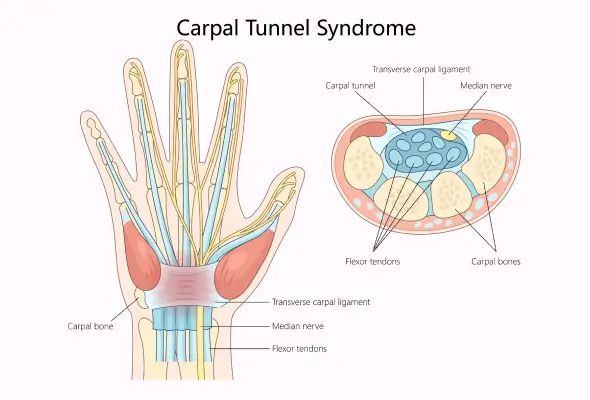-
Doctors
-
Specialities & Treatments
Centre of Excellence
Specialties
Treatments and Procedures
Hospitals & Directions HyderabadCARE Hospitals, Banjara Hills CARE Outpatient Centre, Banjara Hills CARE Hospitals, HITEC City CARE Hospitals, Nampally Gurunanak CARE Hospitals, Musheerabad CARE Hospitals Outpatient Centre, HITEC City CARE Hospitals, Malakpet
HyderabadCARE Hospitals, Banjara Hills CARE Outpatient Centre, Banjara Hills CARE Hospitals, HITEC City CARE Hospitals, Nampally Gurunanak CARE Hospitals, Musheerabad CARE Hospitals Outpatient Centre, HITEC City CARE Hospitals, Malakpet Raipur
Raipur
 Bhubaneswar
Bhubaneswar Visakhapatnam
Visakhapatnam
 Nagpur
Nagpur
 Indore
Indore
 Chh. Sambhajinagar
Chh. SambhajinagarClinics & Medical Centers
Book an AppointmentContact Us
Online Lab Reports
Book an Appointment
Consult Super-Specialist Doctors at CARE Hospitals

Carpal Tunnel Syndrome
Symptom, Causes, Diagnosis and Treatment
Carpal Tunnel Syndrome
Many people wake up in the middle of the night with numbness or tingling in their hands, not knowing they might have carpal tunnel syndrome. This common condition affects millions worldwide, particularly those who spend long hours typing, using tools, or performing repetitive hand movements. This comprehensive guide explores carpal tunnel disease, from its causes & symptoms to treatment options & prevention strategies.

What is Carpal Tunnel Syndrome?
It is a common nerve and bone-related condition that affects the hand & wrist, causing various uncomfortable symptoms. The condition occurs when the median nerve, running through a narrow passage in the wrist (carpal tunnel), becomes compressed or irritated.
The carpal tunnel is a specialised passageway in the wrist, similar to a tunnel through a mountain. The carpal tunnel creates a pathway for essential structures:
- Nine tendons for finger movement
- The median nerve
- Various blood vessels
- Ligaments and soft tissues
The median nerve plays an elementary role in hand function, providing sensation to most fingers and controlling thumb movements. This nerve helps in both sensory functions (feeling) and motor functions (movement) in the thumb and first three fingers.
When this nerve gets compressed within the carpal tunnel, it can lead to various symptoms & complications. Think of it like a garden hose being stepped on – when pressure is applied, the flow is restricted, causing problems downstream. Similarly, when the median nerve is compressed, it can't function properly, leading to the characteristic symptoms of carpal tunnel syndrome.
Symptoms of Carpal Tunnel Syndrome
This condition can be unilateral (involving one wrist) or bilateral carpal tunnel syndrome (involving both wrists). The primary symptoms include:
- Numbness in wrist, hand, and fingertips
- Tingling sensations, similar to pins and needles
- Nerve pain in the wrist, hand, or fingers
- Weakness when gripping objects
- Difficulty with precise movements
These symptoms usually develop gradually over time, with initial signs often appearing at night. Many individuals report being awakened by discomfort, which may feel like sharp, burning stabs or a constant ache. As the condition progresses, these sensations can also begin to occur during daytime activities.
People might need help with routine tasks such as holding a phone, gripping a steering wheel, or typing on a keyboard. The discomfort often feels like it's coming from inside the hand or wrist rather than surface-level pain. Some individuals experience a sensation similar to their hands "falling asleep," leading them to shake their hands as if trying to fling water off them.
One distinctive characteristic is the effect on hand strength and dexterity. Tasks requiring precise finger movements, such as buttoning a shirt, may become increasingly difficult. This decreased coordination and strength can make even simple daily activities challenging and frustrating.
Causes & Risk Factors of Carpal Tunnel Syndrome
Recent research indicates that genetics play a more significant role than previously thought, with family history being a crucial risk factor.
- Several medical conditions significantly increase the risk of developing carpal tunnel syndrome:
- Diabetes (approximately 20% of diabetic patients develop the condition)
- Rheumatoid arthritis
- Hypothyroidism
- Obesity
- Pregnancy
- High-risk Activities:
- Repetitive hand and wrist movements
- Use of vibrating power tools
- Prolonged flexion or extension of the wrist
- Assembly line work
- Food processing and packing
Complications of Carpal Tunnel Syndrome
Permanent nerve damage is one of the most serious complications. When the median nerve remains compressed for extended periods, it can result in irreversible damage. This can lead to:
- Permanent loss of feeling in fingers and thumb
- Decreased hand coordination
- Difficulty performing basic tasks
- Muscle weakness in the affected hand
- Permanent loss of hand function
Diagnosis
During the physical examination, doctors assess hand strength and sensation while looking for specific indicators. They may perform several specialised tests to evaluate the condition:
- Tinel's Sign Test: The doctor taps over the hand's median nerve to check for tingling sensations
- Phalen's Test: Involves pushing the dorsal surface of hands together for 30-60 seconds
- Carpal Compression Test: Applying pressure over the median nerve for 30 seconds to check for numbness
- Electromyography (EMG): EMG measures muscle electrical activity using thin-needle electrodes, while nerve conduction studies assess the speed of electrical impulses through the median nerve. These tests help determine the severity of nerve compression and rule out other conditions that might cause similar symptoms.
Carpal Tunnel Syndrome Treatment
Doctors typically start carpal tunnel treatment with conservative approaches before considering more invasive procedures.
- Non-surgical Treatment: The initial treatment phase focuses on non-surgical options:
- Wrist Splinting: Particularly effective when worn at night to keep the wrist straight
- Physical Therapy: Includes nerve and tendon gliding exercises for symptom relief
- Lifestyle Modifications: Changes to workplace equipment and daily activities
- Anti-inflammatory Medications: Over-the-counter pain relievers for temporary relief
- Corticosteroid Injections: Provide temporary relief and reduce inflammation
- Surgery: When conservative treatments do not provide relief, doctors may recommend surgical intervention. The two main surgical approaches are open surgery and endoscopic surgery. During these procedures, surgeons release the pressure on the median nerve by dissecting the transverse carpal ligament.
The endoscopic approach typically results in less post-operative pain & faster recovery compared to open surgery.
When to See a Doctor
Warning signs that require medical attention:
- Persistent numbness in hands and fingers
- Recurring pain or tingling sensations
- Weakness affecting daily activities
- Changes in hand function or sensation
- Symptoms that interfere with sleep
Prevention
Prevention focuses on protecting the wrists and hands through proper positioning and movement techniques.
Workplace Ergonomics: People should maintain proper posture and ensure their work setup supports neutral wrist positions. This includes using ergonomic devices and maintaining appropriate desk height for comfortable hand positioning.
Regular breaks are essential for preventing strain. Taking 10-15 minute breaks every hour allows hands and wrists to rest and recover. During these breaks, individuals can perform simple exercises to maintain flexibility:
- Shake hands gently for 1-2 minutes
- Make fists and then stretch your fingers out
- Perform gentle wrist stretches
- Practice tendon gliding exercises
Additional Preventive Measures:
- Maintain neutral wrist positions during activities
- Avoid repetitive hand movements when possible
- Use appropriate grip strength for tasks
- Keep hands warm to prevent stiffness
- Consider wearing wrist splints during sleep
Conclusion
Carpal tunnel syndrome might start with mild discomfort, but its effects can seriously impact daily activities and work performance. Treatment success rates remain high when the condition is caught early. Simple changes like proper wrist positioning, regular breaks, and ergonomic workplace setups can prevent or slow the condition's progress. Medical treatments ranging from splinting to surgery offer practical solutions for most patients when needed.
People experiencing persistent hand numbness, tingling, or weakness should not wait to seek medical help. Quick action and proper preventive measures give the best chance to manage carpal tunnel syndrome and maintain long-term hand health. Regular hand exercises, proper ergonomics, and workplace adjustments create a strong foundation for protecting wrists and hands from this common condition.
FAQs
1. How severe is a carpal tunnel syndrome?
Carpal tunnel syndrome may cause permanent damage to the nerve if left untreated. The condition typically worsens over time, potentially causing irreversible dysfunction of the hand, including loss of sensation and weakness. Early intervention can prevent long-term complications.
2. What is the fastest way to recover from a carpal tunnel?
Recovery depends on the severity and treatment approach. For mild cases, symptoms may improve within six months with proper care. Key recovery elements include:
- Wearing a wrist splint during sleep and aggravating activities
- Taking regular breaks from repetitive movements
- Following prescribed exercises and stretches
3. Why is carpal tunnel worse at night?
Nighttime aggravation occurs due to several factors:
- Sleep positions that flex or extend the wrist
- Reduced blood flow to extremities during sleep
- Hormonal changes affecting fluid retention
4. Is carpal tunnel serious?
The condition requires attention as it affects 1-3 cases per 1,000 people annually. While not life-threatening, it can cause complete, irreversible median nerve damage if untreated, severely impacting hand function.
5. What age does carpal tunnel start?
The susceptible age range for developing carpal tunnel syndrome is 45-60 years, with only 10% of patients being younger than 31 years. However, the condition can affect people of any age.
6. What does carpal tunnel syndrome feel like?
Patients typically experience a combination of sensations:
- Numbness in fingers and fingertips
- Sharp, burning pain or constant aching
- Tingling sensations similar to "pins and needles"
- Weakness when gripping objects
7. Can carpal tunnel affect your legs?
While carpal tunnel syndrome affects explicitly the hands and wrists, similar nerve compression symptoms can occur in other body parts. However, leg symptoms suggest a different condition and require separate medical evaluation.
Still Have a Question?




